Abstrakt
In the New Testament, there are over thirty Aramaic words and phrases that are transcribed into Greek characters.
Approximately half of them are personal and place names. Another half are individual words and four
short phrases. This paper catalogues them and proposes Aramaic counterparts.
Bibliografia
Abramowiczówna 1958–1965: Z. Abramowiczówna (red.), Słownik grecko-polski, Warszawa
–1965.
Aland, Aland, Karavidopoulos, Martini, Metzger 2014: B. Aland, K. Aland, J. Karavidopoulos, C.M. Martini, B.M. Metzger (ed.), Novum Testamentum Graece post Eberhard et Erwin Nestle editione vicesima septima revisa, Stuttgart 2004.
Bar-Asher Siegal 2013: E.A. Bar-Asher Siegal, Introduction to the Grammar of Jewish Babylonian Aramaic, Münster 2013.
Buth 2014: R. Burth, The Riddle of Jesus’ Cry from the Cross: The Meaning of ηλι ηλι λαμα
σαβαχθανι (Matthew 27:46) and the Literary Function of ελωι ελωι λειμα σαβαχθανι (Mark
:34), [w:] The Language Environment of First Century Judaea, R. Buth, R.S. Notley (ed.),
Leiden 2014, 395–421.
Buth, Pierce 2014: R. Buth, Ch. Pierce, Hebraisti in Ancient Texts: Does Ἑβραϊστί Ever Mean
‚Aramaic’?, [w:] The Language Environment of First Century Judaea, R. Buth, R. S. Notley
(ed.), Leiden 2014, 66–109.
Cogan, Tadmor 1988: M. Cogan, H. Tadmor, II Kings: A New Translation with Introduction and Commentary, Garden City 1988.
Cotton, Di Segni, Eck, Isaac, Kushnir-Stein, Misgav, Price, Roll, Yardeni 2010: H.M. Cotton, L. Di Segni, W. Eck, B. Isaac, A. Kushnir-Stein, H. Misgav, J. Price, I. Roll, A. Yardeni, Corpus Inscriptionum Iudaeae/Palaestinae, vol. I: Jerusalem, part I: 1–704, Berlin 2010.
Coussement 2016: S. Coussement, „Because I Am Greek”: Polyonymy as an Expression of Identity in Ptolemaic Egypt, Leuven 2016.
Cowley, Kautzsch 1910: A.E. Cowley, E. Kautzsch (ed.), Gesenius’ Hebrew Grammar, Oxford 1910.
Dalman 1905: G. Dalman, Grammatik des jüdisch-palästinischen Aramäisch nach den Idiomen des palästinischen Talmud, des Onkelostargum und Prophetentargum und der jerusalemischen Targume, Leipzig 1905.
Eynikel, Hauspie, Lust 1996: E. Eynikel, K. Hauspie, J. Lust, A Greek-English Lexicon of the
Septuagint, Stuttgart 1996.
Eskhult, Eskhult 2013: M. Eskhult, J. Eskhult, The Language of Jesus and Related Questions:
A Historical Survey, „KUSATU: Kleine Untersuchungen zur Sprache des Alten Testaments
und seiner Umwelt” 15, 2013, 315–373.
Even-Shoshan 2003: A. Even-Shoshan, 2003.
Finley 2006: Th. Finley, „Upon This Rock”: Matthew 16.18 and the Aramaic Evidence, „Aramaic Studies” 4, 2006, 133–151.
Fitzmyer 1979: J.A. Fitzmyer, A Wandering Aramean. Collected Aramaic Essays, Missoula 1979.
Fitzmyer, Harrington 2000: J.A Fitzmyer, D.J. Harrington, A Manual of Palestinian Aramaic Texts (Second Century B. C. - Second Century A. D.), Roma 2000.
Gzella 2015: H. Gzella, A Cultural History of Aramaic. From the Beginnings to the Advent of
Islam, Leiden 2015.
Haspelmath 2009: M. Haspelmath, Lexical Borrowing. Concepts and Issues, [w:] Loanwords in the World’s Languages. A Comparative Handbook, M. Haspelmath, U. Tadmor (ed.), Berlin 2009, 35–54.
Herrmann 1999: W. Herrmann, Baal Zebub, [w:] Dictionary of Deities and Demons in the Bible, B. Becking, P.W. van der Horst, K. van der Toorn (ed.), Leiden 1999, 154–156.
Iwaszkiewicz 1996: P. Iwaszkiewicz, Do Ziemi Świętej. Najstarsze opisy pielgrzymek do Ziemi Świętej, Kraków 1996.
Jastrow 1903: A Dictionary of the Targumim, the Talmud Babli and Yerushalmi, and the Midrashic Literature, London 1903.
Koopmans 1962: Aramäische Chrestomathie. Ausgewählte Texte (Inschriften, Ostraka und Papyri) bis zum 3. Jahrhundert n. Chr. für das Studium der aramäischen Sprache gesammelt, vol I: Einleitungen, Literatur und Kommentare, Leiden 1962.
Maccuzzo 2006: C. Maccuzzo, Εἰς τί; ‚Perché?’ (Mc 15,34), [w:] Grammatica intellectio
Scripturæ: Saggi filologici di Greco biblico in onore di Lino Cignelli OFM, R. Pierri OFM
(ed.), Jerusalem 2006, 205–216.
Metzger 2000: B.M Metzger, A Textual Commentary on the Greek New Testament, Stuttgart
Modrzejewski 2000: J.M. Modrzejewski, Żydzi nad Nilem od Ramzesa II do Hadriana, Kraków 2000.
Ong 2016: H.T. Ong, The Multilingual Jesus and the Sociolinguistic World of the New Testament, Leiden 2016.
Pazzini 1999: M. Pazzini, Grammatica siriaca, Jerusalem 1999.
Popowski 1995: R. Popowski SDB, Wielki słownik grecko-polski Nowego Testamentu. Wydanie z pełną lokalizacja greckich haseł, kluczem polsko-greckim oraz indeksem form czasownikowych, Warszawa 1995.
Radożycki 2001: J. Radożycki, Józef Flawiusz: Wojna żydowska, Warszawa 2001.
Segert 1983: S. Segert, Altaramäische Grammatik mit Bibliographie, Chrestomathie und Glossar, Leipzig 1983.
Sokoloff 2002: M. Sokoloff, A Dictionary of Jewish Babylonian Aramaic of the Talmudic and
Geonic Periods, Ramat Gan 2002.
Sokoloff 2002b: M. Sokoloff, A Dictionary of Jewish Palestinian Aramaic of the Byzantine Period, Ramat Gan 2002.
Spolsky 2014: B. Spolsky, The Languages of the Jews: A Sociolinguistic History, Cambridge
Stevenson 1988, W.B. Stevenson, A Grammar of Palestinian Jewish Aramaic, Oxford 1998.
Winnicki 2009: J.K. Winnicki, Late Egypt and Her Neighbours. Foreign Population in Egypt in the First Millennium BC, Warszawa 2009.
Licencja
